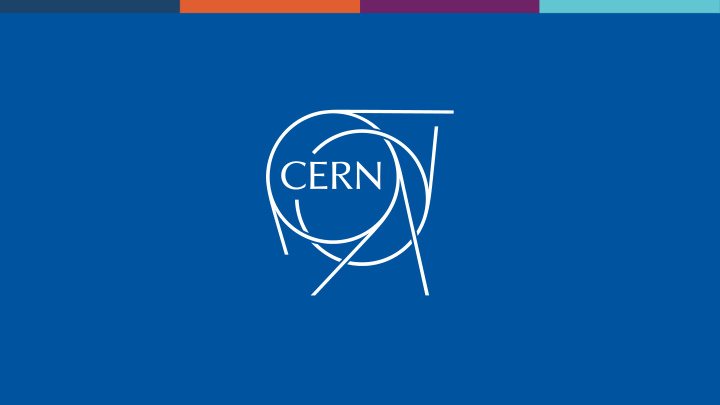



Trends and Directions at CERN ICRI 2018 – Plenary Session 2 Charlotte Lindberg Warakaulle Director for International Relations at CERN CERN Trends and Directions at CERN 28.09.2018 2
Particle Physics Landscape Today CERN now developing towards the High- Luminosity LHC identified as highest priority in 2013 update of European Strategy for Particle Physics (ESPP), while also preparing for the Update of the ESPP to be next accelerator after the LHC with R&D and studies ( Compact Linear Collider and Future Circular kicked off at CERN Council Collider ) session later this month – bottom-up process that will Neutrino programmes in place largely in the US set a roadmap for the and Japan CERN participation via its Neutrino Platform European (and global) context for coming 5-7 yrs as Aspirations for an International Linear Collider part of the foundation for the in Japan looking forward to decision before field in 30 years ’ time the end of the year Discussions for Large Circular Collider in China CDR for China Electron Positron Collider released on 2 Sept. CERN 28.09.2018 3
Strategizing for the future: driven by science • The European Strategy for Participle Physics (ESPP) is a process through which European particle physics community regularly updates the priorities and strategy of the field, resynchronizing with developments and emphases first ESPP in 2006; updated in 2013; next update to be finalized by May 2020. • Bottom-up process that involves the community, driven by physics, with awareness of financial and technical feasibility. • ESPP produces the European roadmap in a worldwide context to feed into, and facilitate, coherent global thinking physics requires global coordination, given the number, size and complexity, with increasing alignment of the European, US and Japanese roadmaps in recent years to optimize the use of resources. CERN Trends and Directions at CERN 28.09.2018 4
Continuing trend: globalization of particle physics 22 Member States : Austria, Belgium, Bulgaria, Czech Republic, Denmark, Finland, France, Germany, Greece, Hungary, Israel, Italy, Netherlands, Norway, Poland, Portugal, Romania, Slovak Republic, Spain, Sweden, Switzerland and United Kingdom 3 Associate Member States in the pre-stage to membership : Cyprus, Serbia and Slovenia 5 Associate Member States : India, Lithuania, Pakistan, Turkey and Ukraine 3 Observers : Japan, Russia and the United States of America 50+ Non-Member States Collaborating with CERN through Cooperation Agreements • Number of users is a KPI of the attractiveness of research infrastructures European leadership in the field of high-energy particle physics • Growth in reach and depth of global community complemented by contributions to infrastructure CERN Trends and Directions at CERN
Particle Physics in 30 years? Particle physics in 30 years • Particle physics is inherently long- term – the High-Luminosity LHC is a 20-year programme that is now being put in place, while some of the studies underway project some 50 years into the future • Long-range planning needs to go hand-in-hand with reactivity to developments in the field and in the global context • Important to maintain diversity and a global approach to ensure continued excellence • Sustained support of Member States over decades essential Trends and Directions at CERN CERN 28.09.2018 6
Research infrastructures in 30 years? Evolution will be necessary, to adapt to the challenges of time and developments in the science, while excellence, diversity and an open global approach will remain the cornerstones of world-leading Ris in their respective fields Training of future scientists, engineers to Research selection and operation models remain a core mission, to ensure must remain driven by scientific excellence sustainability and optimise on societal impact Access models will vary across fields – but Interconnection across Ris will be determined important to keep in mind that progress is by needs of research , as experts develop accelerated in unrestricted collaboration , networks as they identify needs for expertise, with balance and reciprocity depending on the field Important to continuously develop and RIs need to be drivers of open science , implement cutting-edge technologies with open access publishing, open software and serve as motors of innovation Need and open hardware increasingly important significant knowledge transfer to society for policymakers and public and socio-economic impact CERN 28.09.2018 7
Thank you
Recommend
More recommend